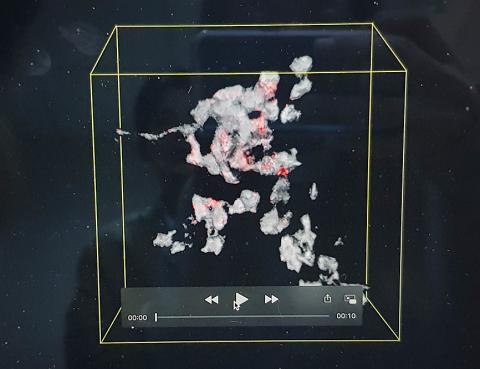A team of researchers yesterday touted novel imaging systems for observing the dynamics of single neurons in living fruit flies’ brains, hoping to apply the tools to understand human brains.
A fruit fly brain contains more than 100,000 cells and measures less than 1mm deep and a rat brain contains about 100 million cells and measures 1cm deep, while a human brain houses up to 100 billion cells and measures 10cm deep, National Taiwan University (NTU) physics professor Chu Shi-wei (朱士維) told a news conference at the Ministry of Science and Technology in Taipei.
To explore the profound mystery of the human brain, the team started with fruit fly (Drosophila) brains, Chu said.

Photo: Chien Hui-ju, Taipei Times, courtesy of Chu Shi-wei
While magnetic resonance imaging and positron emission tomography can take whole human brain images, their resolutions are not enough to probe single neuron behaviors, he said.
Optical microscopes, though limited in penetration depth, are more helpful in observing whole-brain neuronal connections in a small animal like fruit flies, he said.
Aided by engineers and biologists from NTU, National Tsing Hua University and National Chiao Tung University, Chu said his team developed a high-speed volumetric imaging system that might be the first in the world to capture the millisecond-scale 3D neuronal firing dynamics in a living fruit fly brain.
Combining that with a home-built optogenic stimulation system, the team was able to capture the in vivo 3D functional connection and coding of the fly’s visual circuits, he said.
To identify the structural connection of the fly’s nerve fibers, the team also built a system called Confocal Localization Deep-imaging with Optical Clearing, with 20-nanometer spatial resolution, which is 10 times better than that of conventional optical microscopes, he said.
The team also produced a long-wavelength three-photon microscopy enabling whole-brain imaging in a living fruit fly, after they found the penetration depth of conventional two-photon microscopy in fruit fly brain was much less than that in a mouse brain due to their different brain structures, he said.
Chu’s team published four research papers on the achievements in the journals Optics Letters, iScience and Biomedical Optics Express last year.
Chu was also invited by the journal Light: Science and Applications to write an introductory article on optical microscopy, which was published in December last year.
The techniques might improve understanding about neurological diseases, such as Alzheimer’s, in fruit flies and in human brains, Chu added.
While Academia Sinica physicist Hwu Yeu-kuang (胡宇光) and other Asian scientists in January established the Synchrotron for Neuroscience — An Asia Pacific Strategic Enterprise (SYNAPSE) alliance, vowing to produce the world’s first human brain map by 2023, Chu’s team has taken a different approach.
While the alliance aims to use intensified X-ray methods to capture the “structures” of dead brains, the team’s methods purport to observe the brain “functions” in “living” animals by studying connection dynamics, National Tsing Hua University assistant professor of biomedical engineering Chu Li-an (朱麗安) said.
However, the team might need to study the brains of other mammals first before their techniques can be applied to humans, she added.

Three Taiwanese airlines have prohibited passengers from packing Bluetooth earbuds and their charger cases in checked luggage. EVA Air and Uni Air said that Bluetooth earbuds and charger cases are categorized as portable electronic devices, which should be switched off if they are placed in checked luggage based on international aviation safety regulations. They must not be in standby or sleep mode. However, as charging would continue when earbuds are placed in the charger cases, which would contravene international aviation regulations, their cases must be carried as hand luggage, they said. Tigerair Taiwan said that earbud charger cases are equipped

Foreign travelers entering Taiwan on a short layover via Taiwan Taoyuan International Airport are receiving NT$600 gift vouchers from yesterday, the Tourism Administration said, adding that it hopes the incentive would boost tourism consumption at the airport. The program, which allows travelers holding non-Taiwan passports who enter the country during a layover of up to 24 hours to claim a voucher, aims to promote attractions at the airport, the agency said in a statement on Friday. To participate, travelers must sign up on the campaign Web site, the agency said. They can then present their passport and boarding pass for their connecting international

Taiwan sweltered through its hottest October on record, the Central Weather Administration (CWA) said yesterday, the latest in a string of global temperature records. The main island endured its highest average temperature since 1950, CWA forecaster Liu Pei-teng said. Temperatures the world over have soared in recent years as human-induced climate change contributes to ever more erratic weather patterns. Taiwan’s average temperature was 27.381°C as of Thursday, Liu said. Liu said the average could slip 0.1°C by the end of yesterday, but it would still be higher than the previous record of 27.009°C in 2016. "The temperature only started lowering around Oct. 18 or 19

WEATHER Typhoon forming: CWA A tropical depression is expected to form into a typhoon as early as today, the Central Weather Administration (CWA) said yesterday, adding that the storm’s path remains uncertain. Before the weekend, it would move toward the Philippines, the agency said. Some time around Monday next week, it might reach a turning point, either veering north toward waters east of Taiwan or continuing westward across the Philippines, the CWA said. Meanwhile, the eye of Typhoon Kalmaegi was 1,310km south-southeast of Oluanpi (鵝鑾鼻), Taiwan’s southernmost point, as of 2am yesterday, it said. The storm is forecast to move through central